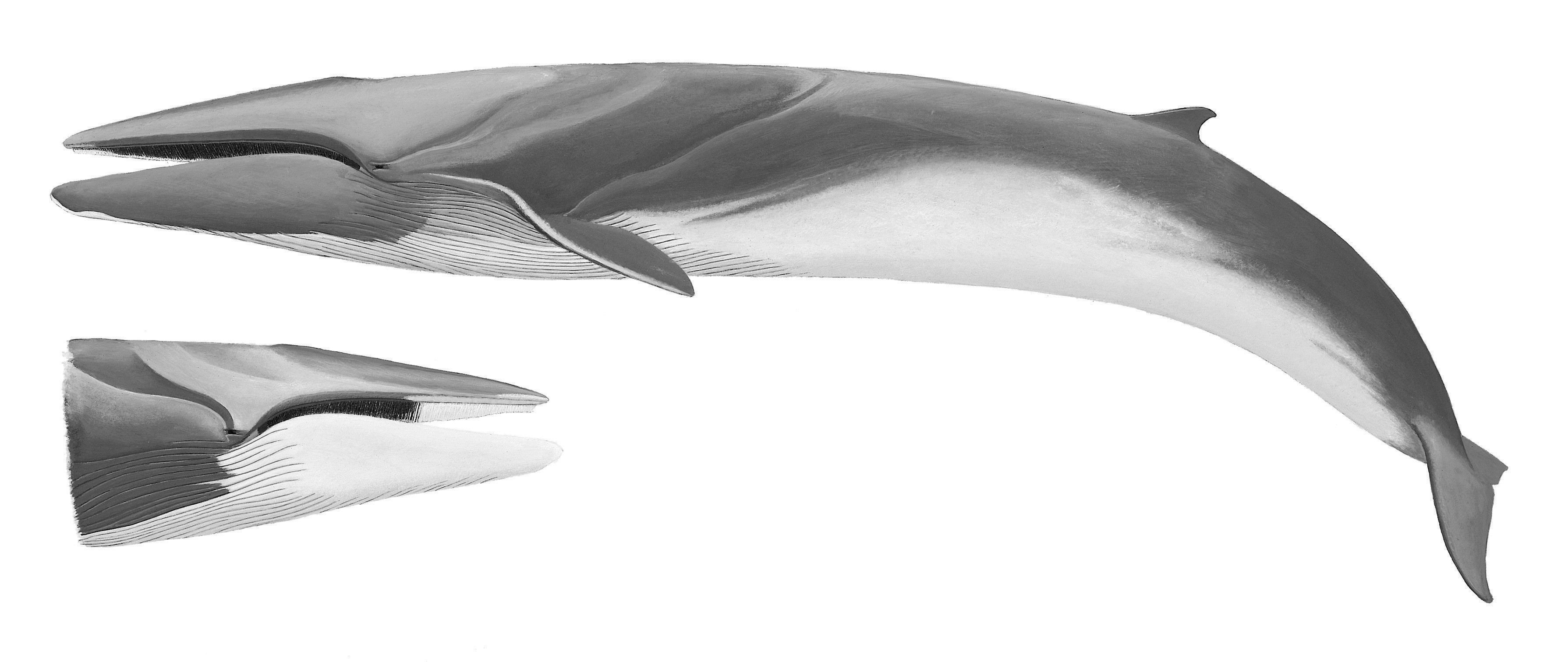FIN WHALE
Balaenoptera physalus (Linnaeus 1758)
Order Cetacea : Family Balaenopteridae
DESCRIPTION. A large, slender whale similar to the blue whale but head V-shaped in dorsal view rather than U-shaped; dorsal fin high and placed even with or posterior to anus on posterior one-fourth of body; pectoral fin about one-ninth of total length; head flattened, with right side more whitish than left; right lower jaw white, left grayish to black; upperparts gray, underparts pure white; grooves on throat numerous and extending beyond navel; whalebone lead color with whitish or yellowish fringes, 45–90 cm long, and over 400 blades on each side. The fin whale is second in size only to the blue whale. Northern hemisphere adults commonly reach maximum lengths of 24 m and maximum weights of 50 metric tons, with females tending to be slightly larger than males. Southern hemisphere animals are even longer, ranging up to 27 m. Fin whales are somewhat slimmer than blue whales of comparable length and therefore weigh proportionally less. The dorsal fin, located farther from the tail flukes than in the blue whale, is taller and may reach a height of 61 cm. The fin whale has 50–100 long throat pleats that reach back to the navel.

DISTRIBUTION. Fin whales have a cosmopolitan distribution. As for most of the rorquals, fin whale occurrence in the Gulf of Mexico is considered accidental. Eight confirmed records of fin whales, five strandings and three sightings, have been recorded in the Gulf of Mexico. One of the stranding records is of a young individual, 5.5 m in length, that stranded on the beach at Gilchrist, Chambers County, on 21 February 1951. A second stranding was recorded from the Texas coast at Mustang Island, Aransas County, on 8 February 2010.
SUBSPECIES. Balaenoptera p. physalus.
HABITS. Northern hemisphere adult fin whales are highly migratory. The whales move to high-latitude feeding grounds during spring and summer and return to southerly, temperate waters for mating and calving during autumn and winter. Because of asynchronous seasons, northern and southern hemisphere populations do not interbreed.
Fin whales feed mainly on krill but also eat schooling fishes, including herring, cod, mackerel, pollock, sardine, and capelin. Fish are eaten more often in winter.
The reproductive habits of these whales remain largely unknown. Mating and calving occur from November to March in temperate waters. The gestation period is approximately 11 months, and newborn fin whales are about 6.4 m in length and weigh 1.8 metric tons. The period of lactation lasts 6–7 months, and after weaning, the young whales are approximately 12.2 m long. Sexual maturity is reached at 6–12 years of age. Females are thought to give birth only at 3-year periods.
POPULATION STATUS. Extralimital; rare; strandings and observations. Although fin whales are the second most frequently reported baleen whale from the Gulf, after Bryde's whale, most cetologists believe these are accidental occurrences of stray animals that wandered into the Gulf from outside the region.
CONSERVATION STATUS. The USFWS, TPWD, and IUCN all list the fin whale as endangered. The IUCN lists the population trend as unknown, noting that the global population has declined by >70% over the last three generations. With the elimination of most whaling in the world, it is possible these whales will begin to increase in number.
From The Mammals of Texas, Seventh Edition by David J. Schmidly and Robert D. Bradley, copyright © 1994, 2004, 2016. Courtesy of the University of Texas Press.
Natural Science Research Laboratory
-
Address
Museum of Texas Tech University, 3301 4th street, Lubbock, TX 79409 -
Phone
806.742.2486 -
Email
nsrl.museum@ttu.edu

